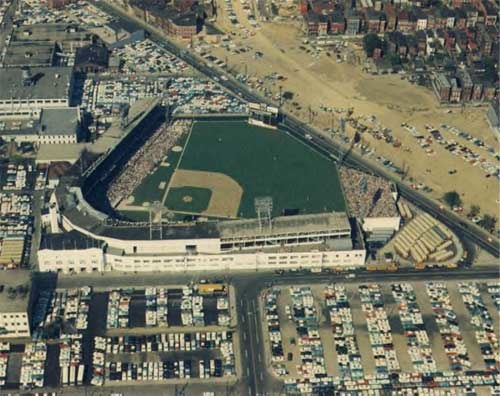
As it ends up, 1912 was a pretty good year for Major League Ballparks: Besides Fenway Park, fans also were treated to two other new diamond palaces: Crosley Field and Tiger Stadium.
Crosley Field, shown above, was actually the first of the three to open; on April 11, 1912, the Reds defeated the Chicago Cubs, 10-6, as a sellout crowd arrived at the ballpark via Model T, electric streetcar (the fare: five cents) and horse-drawn wagon to see the brand-new Redland Field open at a familiar location: the steel-and-concrete ballpark opened on the site of two previous Reds ballparks, Palace of the Fans and League Park. On the smaller size — the capacity was 25,000 — and a more modest facility before renovations extended the grandstand roof in later years — Redland Field was a major draw in a community that loved its baseball.
There weren’t any surprises that Opening Day: the ballpark had already been put through its paces when the Boston Red Sox came through town, barnstorming their way from Hot Springs, Ark. training camp to their own new facility in Boston. The two exhibition games didn’t yield any issues with the ballpark (though the unseasonably cold temperatures did impact fans), so things were a go for the ballpark opening.
Over the years the $225,000 investment in a new ballpark served the Reds well, as the facility stood the test of time and hosting the team until 1970. Powel Crosley Jr. and Larry MacPhail tinkered with the ballpark configuration, moving home plate out twenty feet and adding roofed upper decks to the left and right field pavilions in 1939.
After the Reds moved to Riverfront Stadium, the ballpark was used to house impounded cars before it was torn down in 1972. The fact that the ballpark was torn down some 40 years may be one reason why it was lost in the anniversary hoopla surrounding the 100th anniversary of Fenway Park. We detail Crosley Field history here.
The wounds are much fresher for Detroit Tigers fans, who are still smarting over the decision to tear down Tiger Stadium in 2009, putting the ballpark just shy of 100 years old. Navin Field was slated to be the final of three new MLB ballparks to open in 1912, but when two Red Sox games at Fenway Park were rained out, they both ended up opening on the same day: April 20, 1912. Navin Field, as it was known at the time, wasn’t much larger than Redland Field — seating some 23,000 in a similar configuration, with most of the seating in a two-deck grandstand and bleachers down each line. It was later expanded by another Tigers owner, Walter Briggs, and as a result Briggs Stadium seated 53,000 by 1938. You can read all about the ballpark’s illustrious history here.
The demise of Tiger Stadium has been well-documented in the past three years, both on this site and in other press outlets. Let’s just say the very mention of Michigan and Trumbull will cause consternation and anger among multiple generations of Tigers fans. Today, there’s not even a plaque commemorating Tiger Stadium at the site.
The steel-and-concrete construction of all three ballparks would presage the opening of another landmark ballpark the following year, when Ebbets Field opened in 1913.
RELATED STORIES: Crosley Field / Cincinnati Reds; Tiger Stadium / Detroit Tigers
—-
Share your news with the baseball community. Send it to us at editors@augustpublications.com.
Are you a subscriber to the weekly Ballpark Digest newsletter? You can sign up for a free subscription at the Newsletter Signup Page.
Join Ballpark Digest on Facebook and on Twitter!
Follow Ballpark Digest on Google + and add us to your circles!
